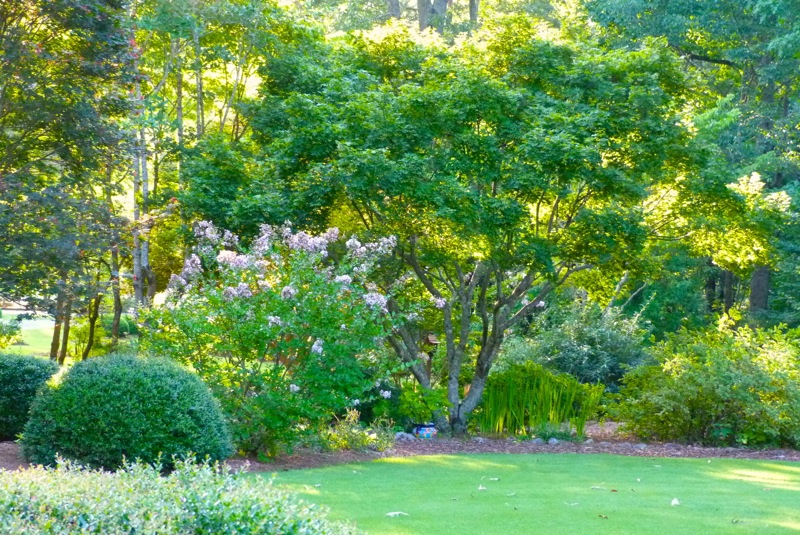Summer Proof the Garden
 Sunday, July 28, 2013 at 4:50PM
Sunday, July 28, 2013 at 4:50PM The doldrums have arrived. Gardening is at a minimum. I prefer to be inside, reading my newest garden magazine. Outside, plants may be loosing their vigor with bright green leaves fading to pale blueish gray, leaf edges crinkled, leaves dropping — all signs of heat stress. Meanwhile, bugs select the weakened plants for midsummer's wildest party, sucking and munching and having an orgy with all their friends and relatives. What's a gardener to do? heat stressed leaves
heat stressed leaves
Don't let the doldrums get you down! Here are ten things one can do to summer proof the garden:
1. Choose the right plants. Many ornamental plants now have heat zone recommendations as well as hardiness zones listed on their tags. Developed by the American Horticultural Society in the late 1990s, the heat zone map identifies 12 heat zones in the US. These heat zones are based upon how many days a year the temperature rises above 86 degrees, the temperature when plant cells begin to deteriorate. I am in heat zone 8, which means there are 91-120 days when temperatures rise above 86. Look to see if a tag has two ratings for a given plant, such as 3-7/4-6. The first set of numbers indicates the plant is winter hardy in hardiness zones 3-7, and the second set of numbers indicates the plant will survive summers in heat zones 4 through 6. Remember the hardiness and heat zone maps are two different maps, so one needs to know both zones for one's location. I am on the edge of hardiness zones 7b/8a, but I am firmly in the middle of heat zone 8. There are plenty of plants that can take my winters but not my summers! Replace plants that die with others that are more likely to survive. Native plants are usually reliable, because they are well adapted to both winter and summer conditions.
2. Another thing that you can do to summer proof your plants is to add compost to the soil. This improves soil texture, creating large pores for water movement and air infiltration. Roots can also spread more easily, allowing the plant to reach nutrients and moisture. One trick to help retain moisture in sandy soil is to add clay based kitty litter.
3. Add a 3-4 inch layer of good organic mulch around the plant, but avoid piling the mulch directly against the base of the plant. I use a lot of pine straw, which complements my naturally acid soil. Avoid artificial mulches or gravel, which will radiate heat around the plant and is more suitable for desert type plants.
4. Mow lawns high. This allows more leaf surface for photosynthesis, the process by which plants turn sunlight into energy. Do not fertilize lawns, except with a weak water based solution or with a top dressing of compost.
5. Water deeply, less often. Frequent shallow watering encourages shallow root growth. Early morning watering is best. Drip irrigation systems winding their way through the plants are ideal. Bury them under the layer of mulch.
6. Group plants according to their water needs.
7. Windbreaks can protect plants against harsh summer winds. Trees, hedges, and fencing are options. Fences should allow air movement through the structure. Solid fences can create heat traps.
8. I like to mix up a summer tonic for my garden. This consist of 2 tbs. of Epsom salts per gallon of water. To this I add fish emulsion or a seaweed fertilizer, prepared according to directions. The Epsom salts provide magnesium and sulfur, which promote photosynthesis. Fish emulsion and seaweed fertilizer supply many trace elements, amino acids, and enzymes that promote plant health and stress tolerance. I apply this to the soil around just about everything in my garden, especially those plants showing heat stress.
9. Provide shade during the hottest part of the day. You can make temporary shades out of shade cloth or other materials. I have seen colorful umbrellas propped here and there in a garden, giving relief to hydrangeas and other heat stressed plants.
10. Move plants in pots to more protected locations. This recent view of my lawn and garden shows that, so far at least, my garden is coming through this year's summer without too much heat stress.It may be tempting to ignore the garden when the summer doldrums strike. There have been years I wanted to give up and let the weeds have it. Don't! Early morning or late afternoon strolls give you an opportunity to check out plants when the temperatures are a bit cooler, and that is also is the best time to get garden chores done. And if you have summer proofed your garden, you and your plants can stay happy, even when the heat and humidity soars.
This recent view of my lawn and garden shows that, so far at least, my garden is coming through this year's summer without too much heat stress.It may be tempting to ignore the garden when the summer doldrums strike. There have been years I wanted to give up and let the weeds have it. Don't! Early morning or late afternoon strolls give you an opportunity to check out plants when the temperatures are a bit cooler, and that is also is the best time to get garden chores done. And if you have summer proofed your garden, you and your plants can stay happy, even when the heat and humidity soars.
 Permalink
Permalink 